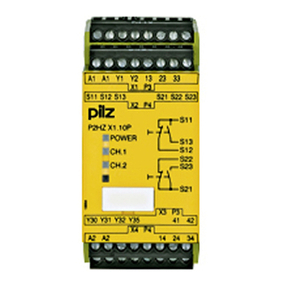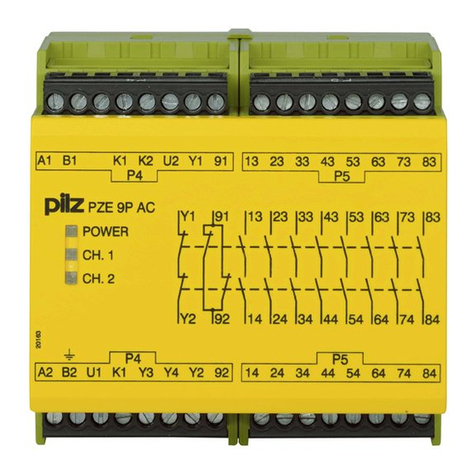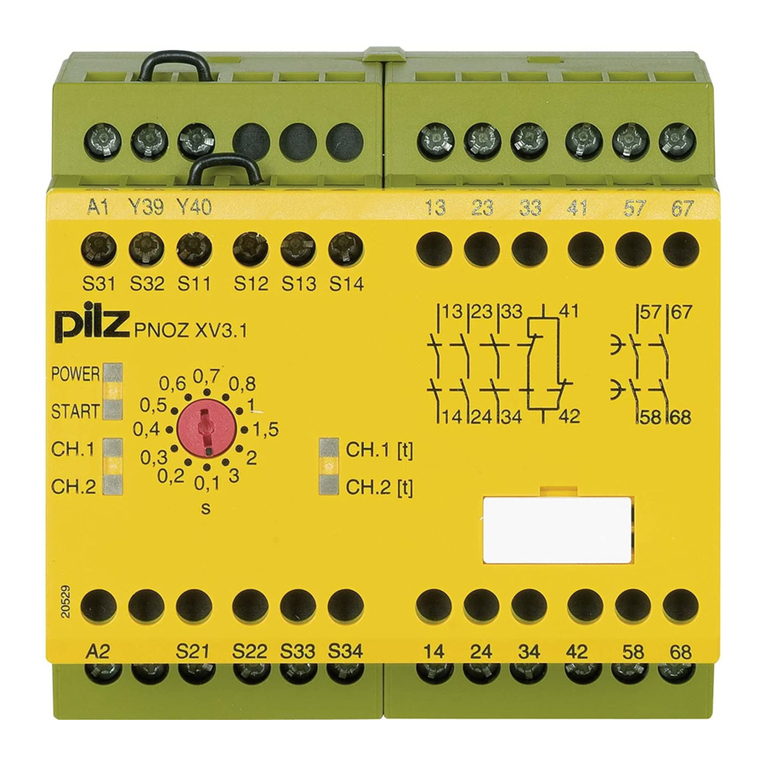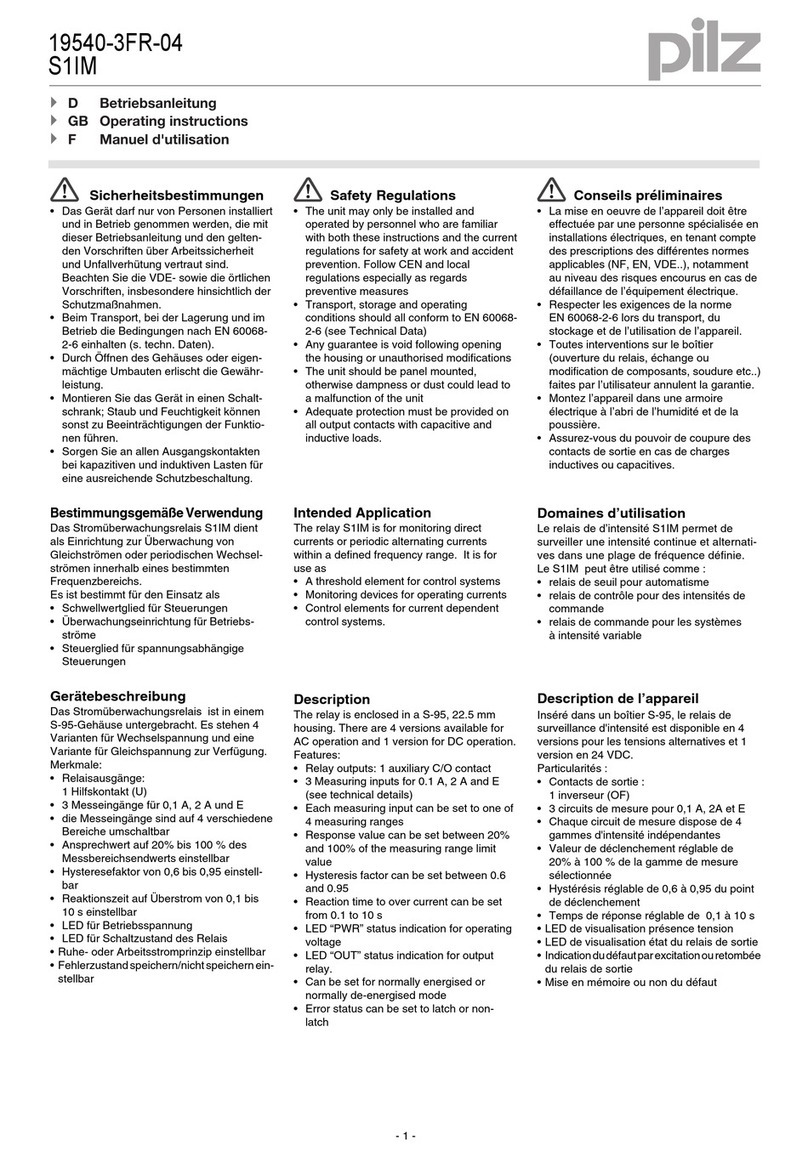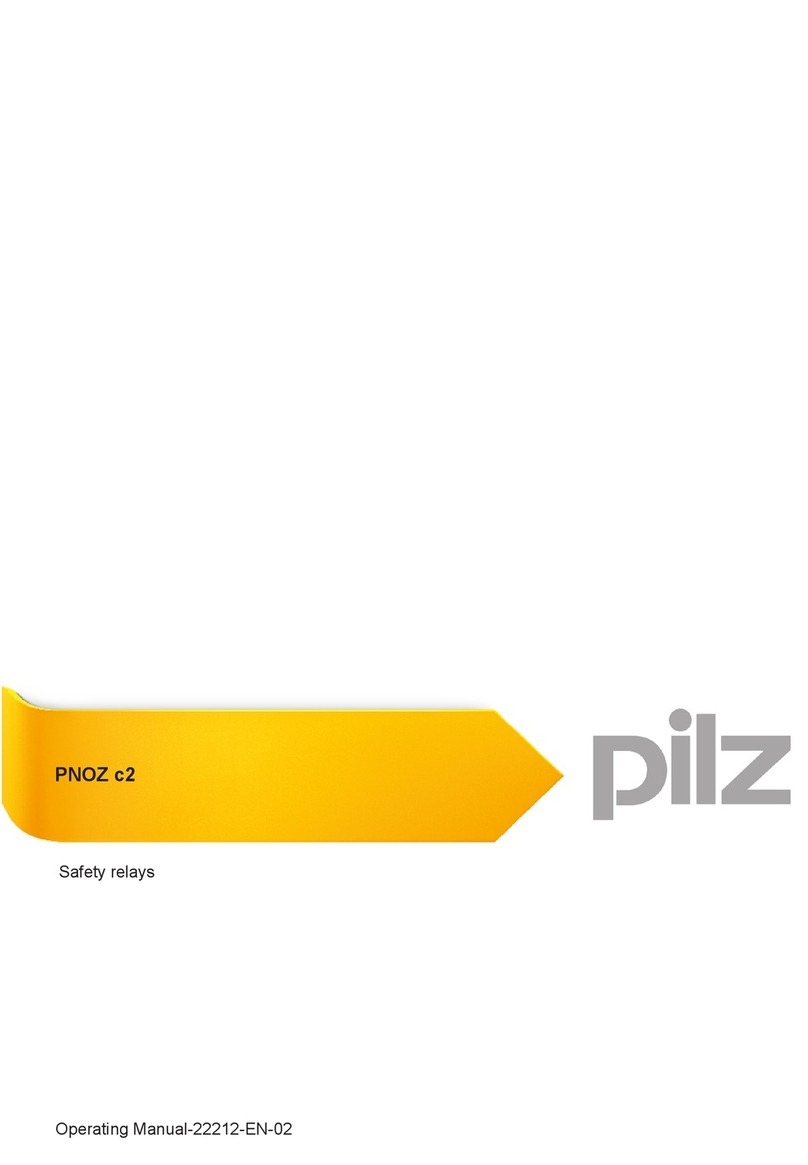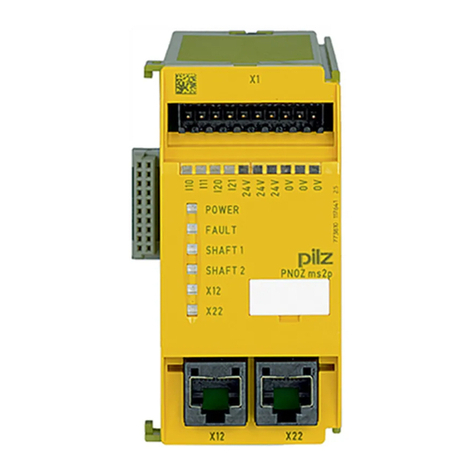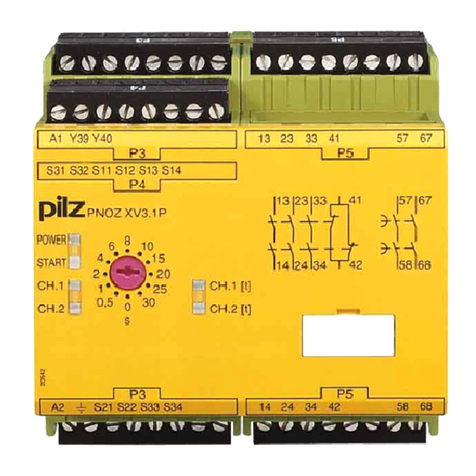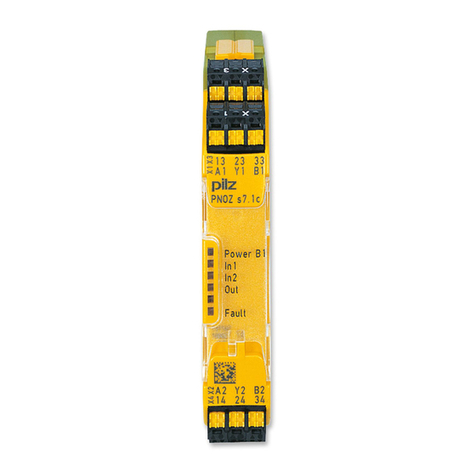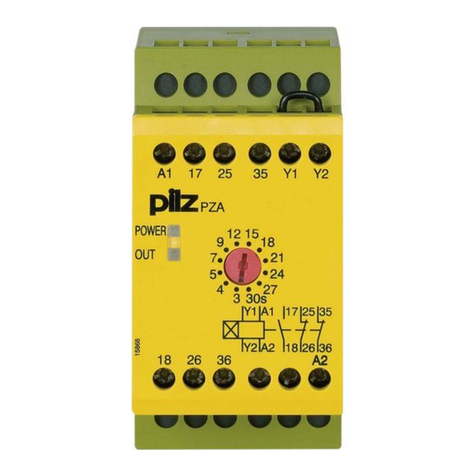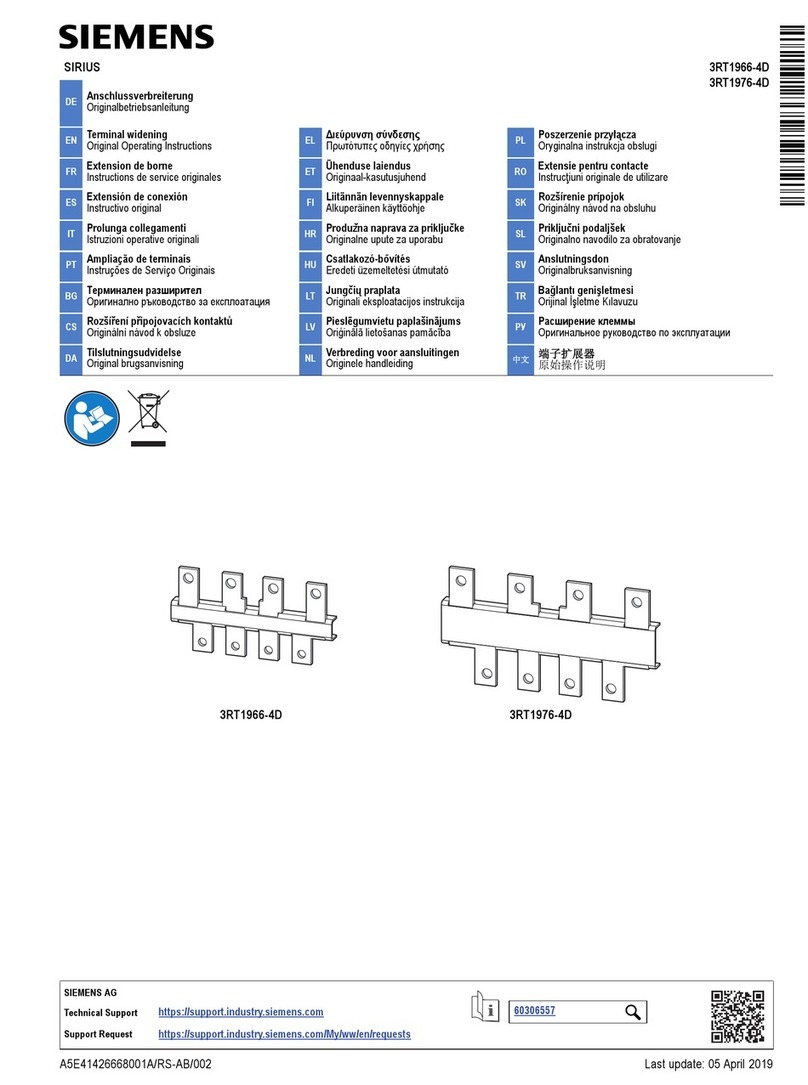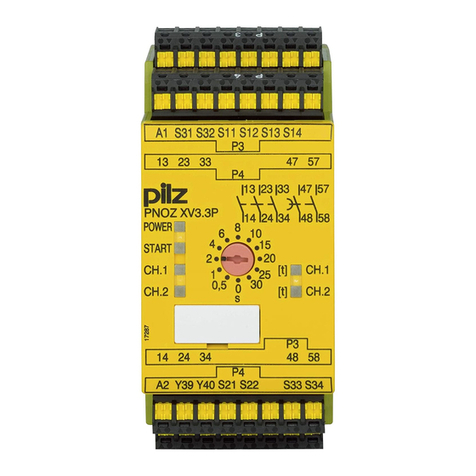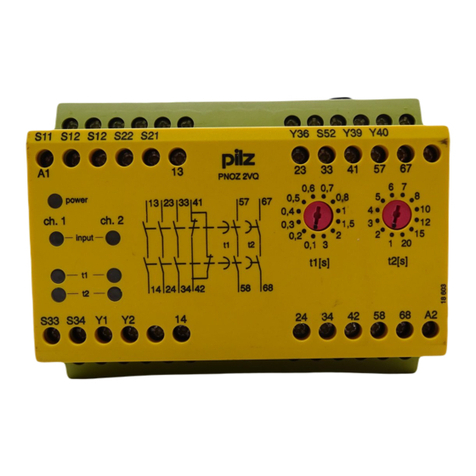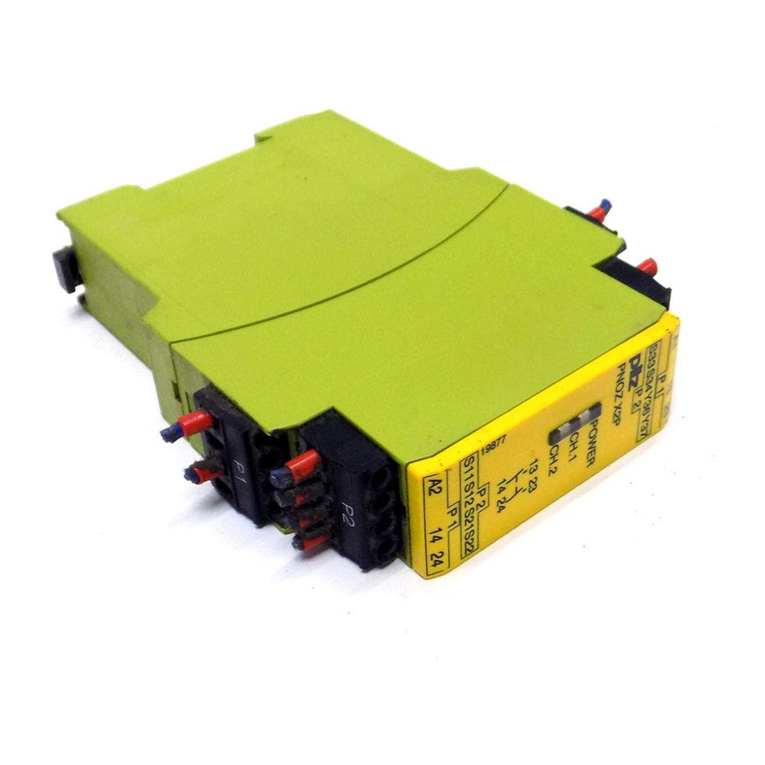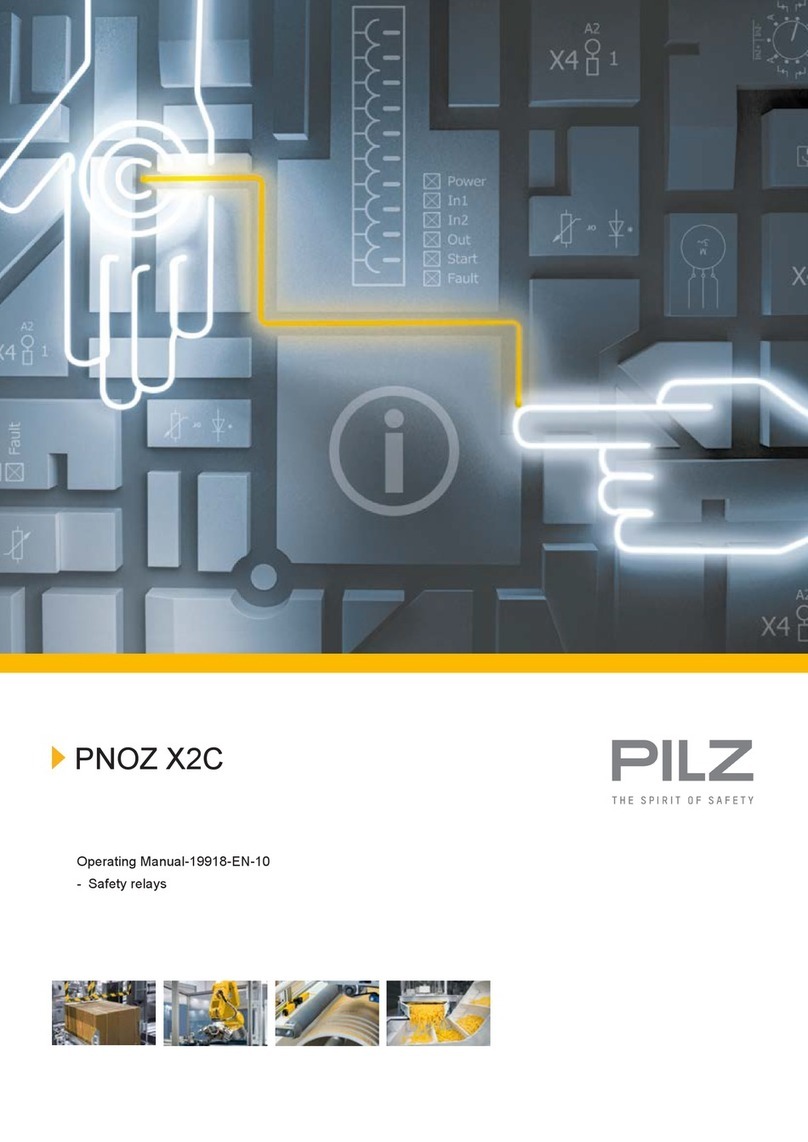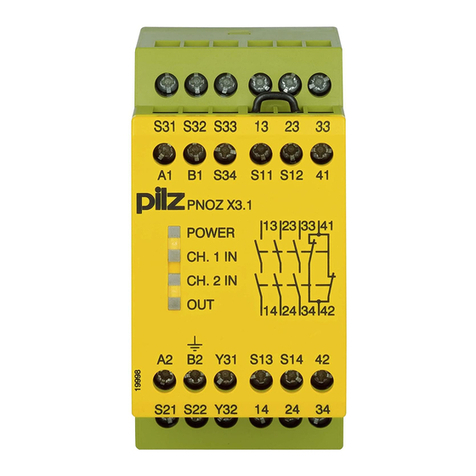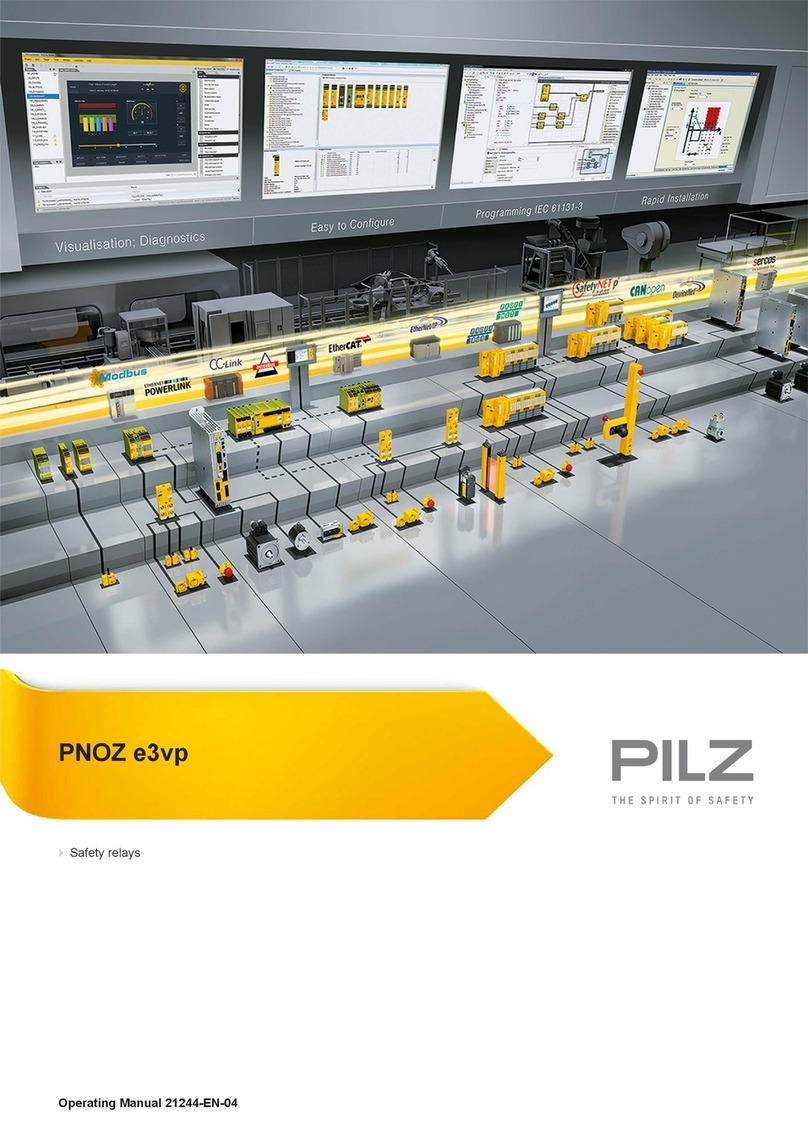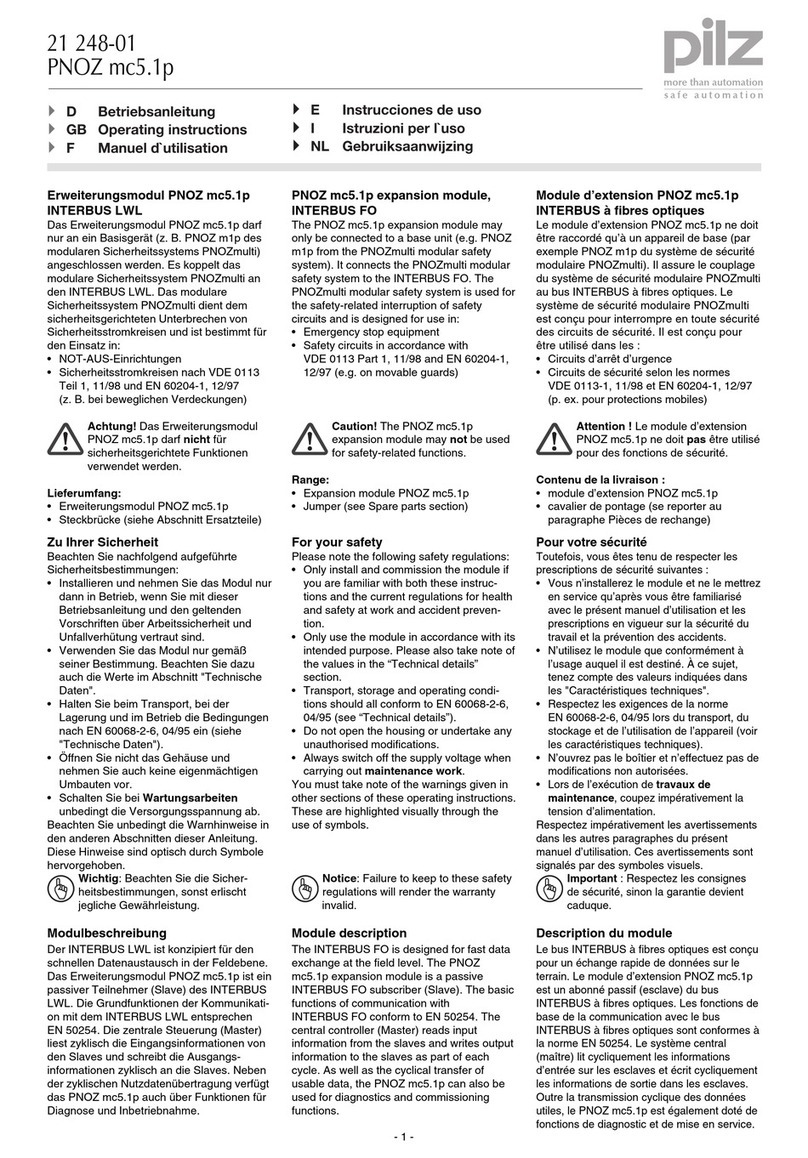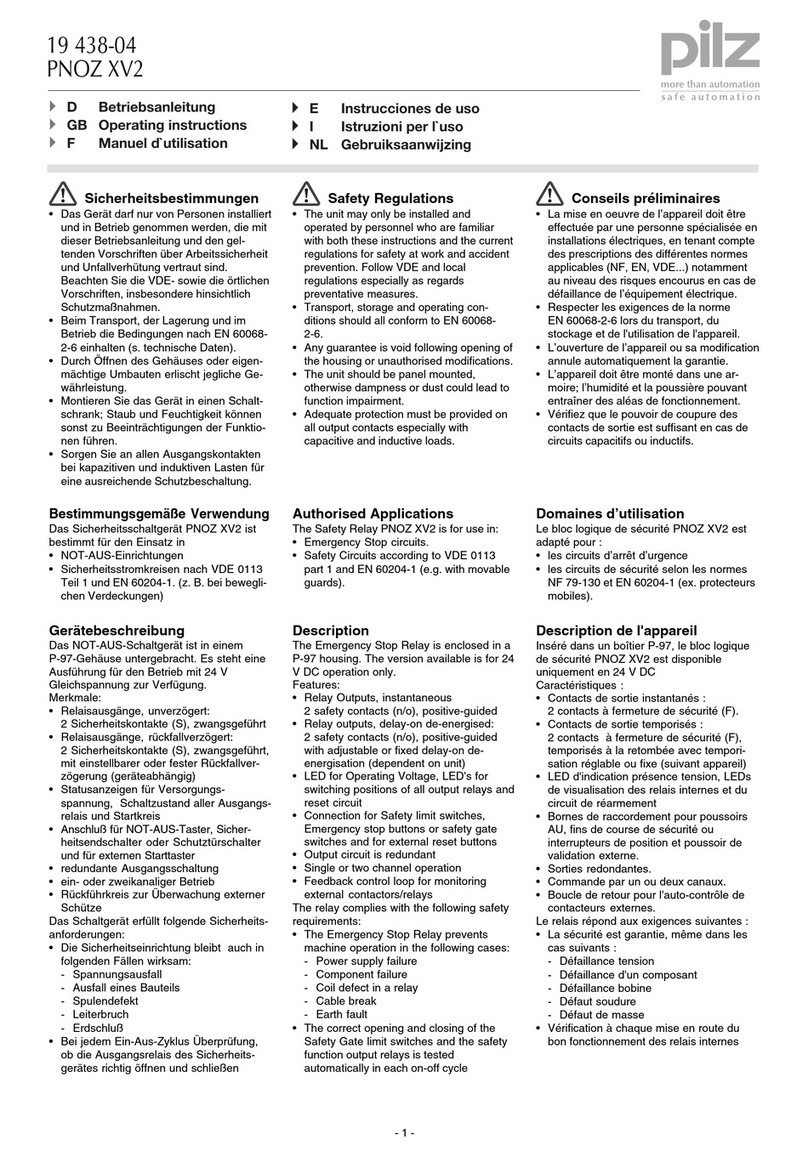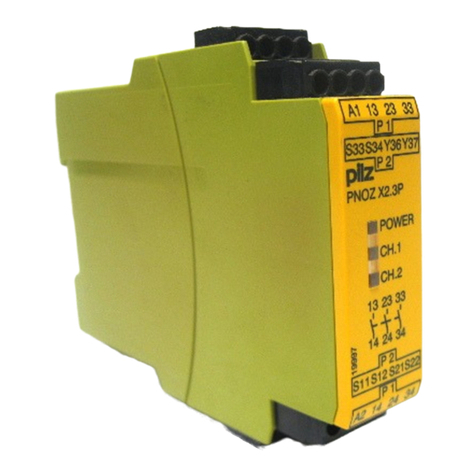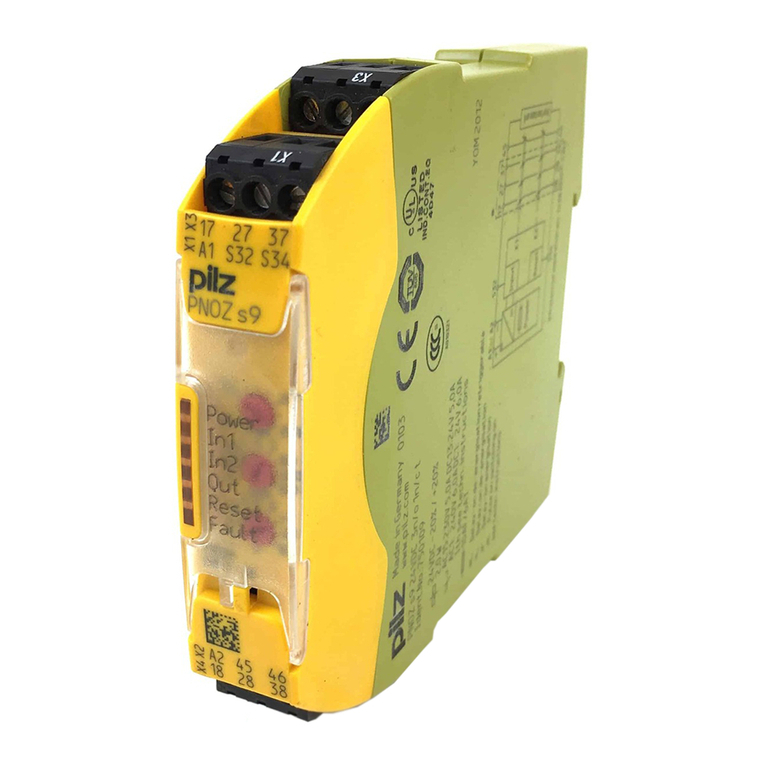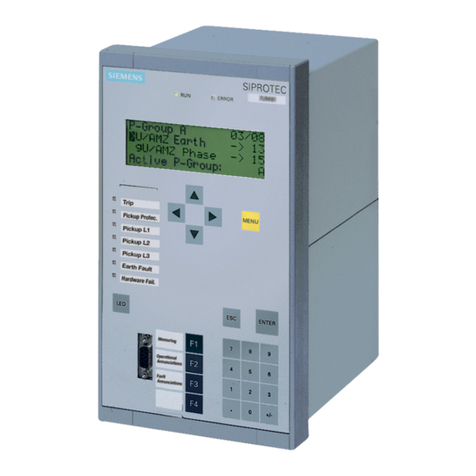
- 7 -
20 545-06
PZE 9P
4E Instrucciones de uso
4I Istruzioni per l`uso
4NL Gebruiksaanwijzing
Prescripciones de seguridad
• El dispositivo tiene que ser instalado y
puesto en funcionamiento exclusivamente
por personas que estén familiarizadas tanto
con estas instrucciones de uso como con
las prescripciones vigentes relativas a la
seguridad en el trabajo y a la prevención de
accidentes. Hay que observar tanto las
prescripciones VDE como las prescripcio-
nes locales, especialmente en lo que se
refiere a las medidas de protección.
• Durante el transporte, el almacenaje y el
funcionamiento hay que atenerse a las
condiciones que se recogen en la sección
"Datos técnicos".
• La garantía se pierde en caso de que se
abra la carcasa o se lleven a cabo modifica-
ciones por cuenta propia.
• Montar el dispositivo dentro de un armario
de distribución; en caso contrario es posible
que el polvo y la suciedad puedan afectar
el funcionamiento.
• Hay que cuidar de que haya un conexiona-
do de seguridad suficiente en todos los
contactos de salida con cargas capacitivas
e inductivas.
Campo de aplicación adecuado
El bloque de contactos PZE 9P sirve como
dispositivo de ampliación para el
reforzamiento y multiplicación de contactos.
El dispositivo ha sido diseñado para ser
empleado en:
• aplicaciones con dispositivos de PARADA
DE EMERGENCIA, supervisores de puer-
tas protectoras y relés de manejo a dos
manos
• circuitos de seguridad según VDE 0113,
parte 1 y EN 60204-1
El dispositivo debe utilizarse sólo con disposi-
tivos base que dispongan de un circuito de
realimentación.
Descripción del dispositivo
El bloque de contactos se encuentra
montado dentro de una carcasa P-99. La
tensión de alimentación es de 24 V AC/DC ó
100 - 240 V AC.
Características:
• Salidas de relé:
8 contactos de seguridad (NA), de guiado
mecánico
1 contacto auxiliar (NC), de guiado
mecánico
• Separación segura de los contactos de
seguridad
23 -24 ... 83-84
- de los circuitos de entrada K1, U1, K2,
U2, Y3, Y4,
- del circuito de realimentación Y1-Y2,
- y del circuito auxiliar 91-92.
• Aislamiento básico de los contactos de
seguridad
13-14
con respecto al resto de
circuitos
• LED como indicación de la tensión de
alimentación
• LEDs como indicadores del estado de
conmutación
Norme di sicurezza
• Il dispositivo può venire installato e mes-
so in funzione solo da persone che cono-
scono bene le presenti istruzioni per l’uso
e le disposizioni vigenti relative alla
sicurezza di lavoro e all’antinfortunistica.
Osservare le disposizioni della VDE
nonché le norme locali, soprattutto per
quanto riguarda le misure preventive di
protezione.
• Durante il trasporto, l’immagazzinamento
e il funzionamento attenersi alle
condizioni prescritte come indicato nei
"Dati tecnici".
• Se viene aperto l’alloggiamento oppure
se vengono apportate delle modifiche in
proprio decade qualsiasi diritto di garanzia.
• Montare il dispositivo in un armadio
elettrico; altrimenti la polvere e l’umidità
possono pregiudicare le funzioni.
• Occorre dotare tutti i contatti di uscita dei
carichi capacitivi e induttivi con un circuito
di sicurezza sufficiente.
Uso previsto
Il modulo contatti PZE 9P funge da modulo
di estensione per l'aumento del numero e
della portata dei contatti.
Il dispositivo è stato concepito per essere
utilizzato in:
• applicazioni con moduli per arresto di
emergenza, controlli ripari mobili e relè
bimanuali
• circuiti di sicurezza secondo VDE 01131 e
EN 60204-1
Il dispositivo può essere solo usato con
moduli base dotati di circuito di retroazione.
Descrizione
Il modulo contatti è inserito in una custodia
P-99.
La tensione di alimentazione è di
24 V AC/DC oppure 100 - 240 V AC.
Caratteristiche:
• uscite relè:
8 contatti di sicurezza (NA), con contatti
guidati
1 contatto ausiliario (NC), con contatti
guidati
• Separazione sicura dei contatti di
sicurezza 23 -24 ... 83-84
- dai circuiti d'ingresso K1, U1, K2, U2,
Y3, Y4,
- dal circuito di retroazione Y1-Y2,
- e dal circuito ausiliario 91-92.
• Isolamento base dei contatti di sicurezza
13-14 da tutti gli altri circuiti
• LED per visualizzazione della tensione di
alimentazione
• LED per visualizzazione dello stato
• collegamento per circuito di retroazione
• comando a singolo canale senza ricono-
scimento del cortocircuito
Veiligheidsvoorschriften
• Het apparaat mag uitsluitend worden
geïnstalleerd en in bedrijf genomen door
personen die vertrouwd zijn met deze
gebruiksaanwijzing en met de geldende
voorschriften op het gebied van arbeids-
veiligheid en ongevallenpreventie. Neem
de van toepassing zijnde Europese
richtlijnen en de plaatselijke voorschriften
in acht, in het bijzonder m.b.t. de veilig-
heidsmaatregelen.
• Neem bij transport, opslag en in bedrijf de
richtlijnen uit de "Technische gegevens"
in acht.
• Het openen van de behuizing of het
eigenmachtig veranderen van de
schakeling heeft verlies van de garantie
tot gevolg.
• Monteert u het apparaat in een schakel-
kast. Stof en vochtigheid kunnen anders
de werking nadelig beïnvloeden.
• Zorg bij capacitieve of inductieve belas-
ting van de uitgangscontacten voor ade-
quate contactbeschermingsmaatregelen.
Gebruik volgens de voorschriften
Het contactblok PZE 9P dient als uitbrei-
dingsrelais voor contactversterking
en -vermeerdering.
Het apparaat is bestemd voor gebruik in:
• Schakelingen met noodstoprelais, hek-
bewakingsrelais en tweehanden-
bedieningsrelais.
• Veiligheidscircuits volgens VDE 0113
deel 1 en EN 60204-1
Het apparaat mag alleen worden gebruikt
met basisrelais die een terugkoppelcircuit
hebben.
Apparaatbeschrijving
Het contactblok is in een P-99-behuizing
ondergebracht.
De voedingsspanning
bedraagt 24 V AC/DC of 100 - 240 V AC.
Kenmerken:
• Relaisuitgangen:
8 veiligheidscontacten (M), mechanisch
gedwongen
1 hulpcontact (V), mechanisch
gedwongen
• Veilige scheiding van de
veiligheidscontacten 23 -24 ... 83-84
- van de ingangscircuits K1, U1, K2, U2,
Y3, Y4,
- het terugkoppelcircuit Y1-Y2,
- en het hulpcircuit 91-92.
• Basisisolatie van veiligheidscontacten 13-
14 ten opzichte van alle andere circuits
• LED voor weergave voedingsspanning
• LED’s voor weergave van de schakel-
toestand
• Aansluiting voor terugkoppelcircuit
• Eenkanalige aansturing zonder detectie
van onderlinge sluiting
